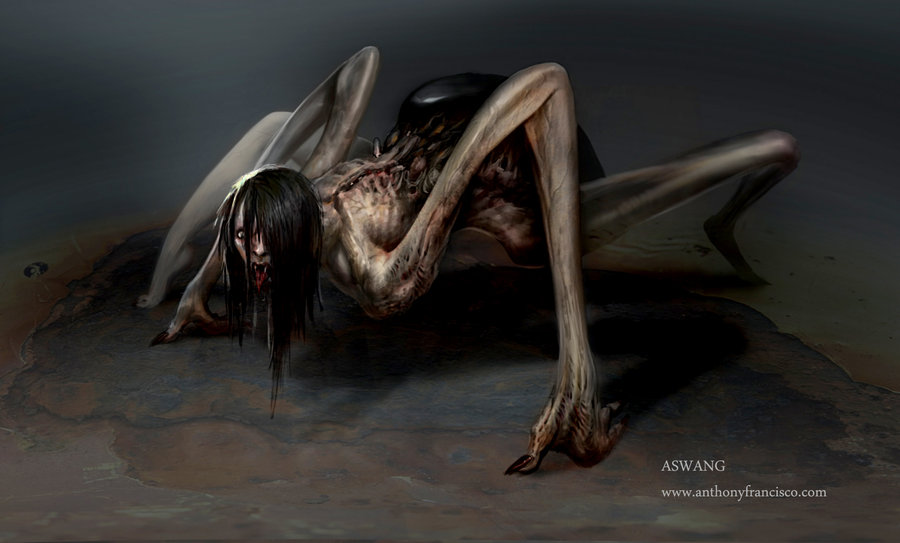Post by Ceratodromeus on Dec 18, 2016 2:47:29 GMT 5

Overview
"An Aswang (or Asuwang) is a shapeshifting monster usually possessing a combination of the traits of either a vampire, a ghoul, a warlock/witch, or different species of werebeast in Filipino folklore or even all of them together. It is the subject of a wide variety of myths and stories. Spanish colonists noted that the Aswang was the most feared among the mythical creatures of the Philippines, even in the 16th century.
The myth of the aswang is well known throughout the Philippines. It is especially popular in the Visayan provinces of Aklan, Antique, Capiz, Iloilo, Guimaras, Negros Occidental, Negros Oriental, Siquijor, Cebu, Bohol, Biliran, Leyte, Southern Leyte, Northern Samar, Eastern Samar, and Samar, as well as Palawan, Romblon, Marinduque, Occidental Mindoro, Oriental Mindoro, Masbate, Quezon, and Batangas in Luzon. Other regional names for the aswang include "tik-tik", "fi-fi", "bayot", "wak-wak", "sok-sok", "mariz" and "kling-kling".
The wide variety of descriptions in the aswang stories makes it difficult to settle upon a fixed definition of aswang appearances or activities. However, several common themes that differentiate aswangs from other mythological creatures do emerge: Aswangs are shape-shifters. Stories recount aswangs living as regular townspeople. As regular townspeople, they are quiet, shy and elusive. At night, they transform into creatures such as a bat, bird (usually an eagle or hawk), boar, cat, or most often, a dog.
They enjoy eating unborn fetuses and small children, favoring livers and hearts. Some have long proboscises, which they use to suck the children out of their mothers' wombs when they are sleeping in their homes. Some are so thin that they can hide themselves behind a bamboo post. They are fast and silent. Some also make noises, like the Tik-Tik, (the name was derived from the sound it produces) which are louder the farther away the aswang is, to confuse its potential victim; and the Bubuu, an aggressive kind of aswang that makes a sound of a laying hen at midnight. They may also replace their live victims or stolen cadavers with doppelgangers made from tree trunks or other plant materials. This facsimile will return to the victim's home, only to become extremely sick and then die. An aswang will also have bloodshot eyes, the result of staying up all night searching for houses where wakes are held to steal the bodies.
Aswangs are physically much more like humans at daytime; they only change their appearance at night when they feel they are in need of food. It has been said that if an aswang married a human, upon their wedding, his or her mate would become an aswang as well but rarely can they reproduce. The couple may hunt together at night but will go in separate directions, either to avoid quick detection or because they do not like to share their food.
Like vampires, aswangs are repelled or killed by using garlic, salt and religious artifacts/weapons (e.g. Holy water, crucifix, rosary, prayers and religious verses). They are also killed using a whip made entirely of a stingray's tail (buntot pagi), which may also be used to repel the creature (aswangs are said to be scared of the sound made by the whip's cord slashing through the air). It is also said that they cannot step on holy consecrated ground (i.e. churches, mosques, temples, etc.). Decapitation is also a way to destroy an aswang.
Certain agimats (native Philippine amulets) and special prayers posted on doors and entrances may also repel aswangs. A good example of which is the red and black bead bracelets worn by newborn babies.
It is said that to spot an aswang at daytime, look straight at their eyes. The person in front of you is an aswang if your reflection is upside-down. Another way of knowing is looking in a tuwad manner; that is, bending over and looking at the person from between your legs, upside-down. The person is an aswang if the image of the person is different. It is said that a person without a philtrum is an aswang. Hintura (Iloilo) is a kind of oil made by albularyos is used to detect if an aswang is near the premises. It is said that the oil will boil and bubble if an aswang is near."
en.wikipedia.org/wiki/Aswang
References for study
- sites.google.com/site/philmyths/lesson-3
- cryptidz.wikia.com/wiki/Aswang
- www.philstar.com/supreme/2015/05/30/1460087/theres-aswang-terrorizing-mindanao-and-yes-please-take-seriously
In the news from June...
Flying lemur mistaken for aswang
"Kagwang, not aswang.
Facebook users are up in arms over a post from June 24 branding a Philippine Flying Lemur "aswang." The lemur is shown being restrained and it is unclear where and how it was caught, and if it is still alive.
Contrary to the user's claims that the kagwang attacked other animals in the area, it is actually a "folivore" or an animal that mainly eats leaves.
he kagwang is endemic to the Philippines, particularly in Mindanao Faunal Region. Bohol.ph lists is as an endangered species.
The photo has been shared over five thousand times since posting, with many spreading information about the flying lemur and discouraging violent behavior against it and other animals.
"The last time I saw kagwang (Philippine flying lemur) was in my early childhood (around 6 or 7 years old) when our neighbor in Sitio Ilawod (Salog) of Brgy Caminto in Inopacan, Leyte caught one," one user wrote. "This post reminds me how disgusting the smell of kagwang was—sobrang anghit, maangsong-maangso, masangsang sa ilong—triple worse than the smell of flying bat. No wonder my old folks would cuss "nanimaho ka nang kagwang" if you forgot or was too lazy to take a bath. The poor kagwang was slaughtered and taken as pulutan."
The user attempted to tag the Department of Environment and Natural Resources and once again spread the detail that the Philippine Flying Lemur is endangered
."
www.gmanetwork.com/news/story/571451/scitech/science/flying-lemur-mistaken-for-aswang#sthash.X9jcWs9R.dpuf


